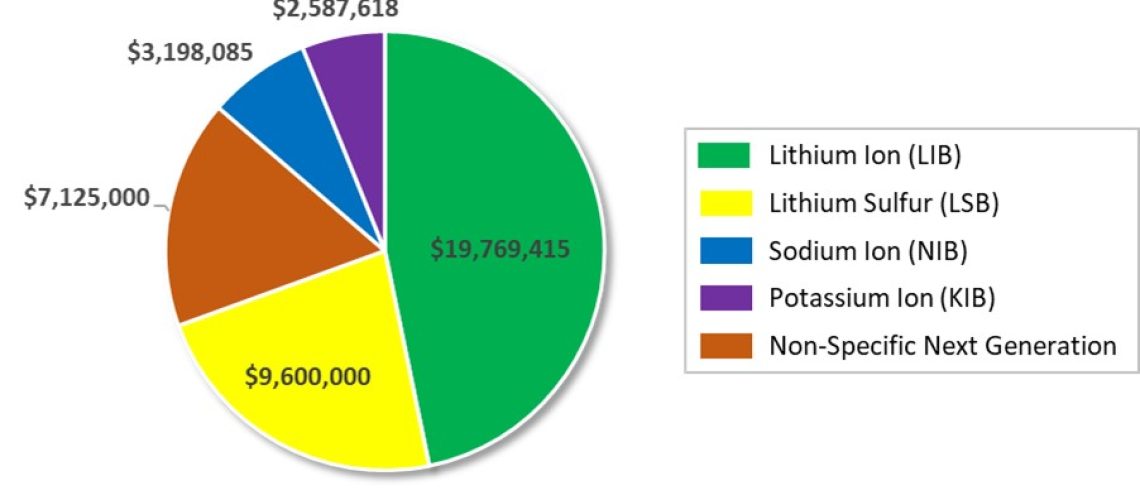On January 10, 2023, the Department of Energy announced the award of $42M USD to advance energy storage technologies through the EVs4All program managed by ARPA-E. These awards went to twelve different recipients in values ranging from $2.1 to $5.6M [1]. The awarded technologies include work to advance the current standard energy storage chemistry, lithium-ion batteries (LIB), but also included a large amount of funding for advanced next generation chemistries like lithium sulfur batteries (LSB), sodium ion batteries (NIB), and potassium ion batteries (KIB) [2].
A deeper breakdown of the awards is instructive as it can highlight the confidence and expectations for different technologies in coming years. It can also provide valuable insight regarding industrial outlook, geographical trends, and the interplay between different development segments.

Figure 1 shows the value of all awards order from high to low. Three of the twelve awards were for $4M or higher. Of these top value awards, two of three were to projects focused on LSB. This includes the largest award of $5.6M to Solid Power Operating for the development of a LSB with a lithium metal anode which can be produced on standard roll-to-roll manufacturing equipment. This project targets a cell with ≥500Wh/kg which would make it very attractive to aviation and aerospace applications as well as automotive. The third largest award went to Zeta Energy for the development of a stable anode for LSB with high-rate capability and cycle life.
Figure 2 illustrates the overall distribution of award funds on a chemistry basis. The projects categorized as Non-Specific Next Generation were the two programs awarded to the national laboratories to look at modeling, testing, and safety evaluation of next generation battery chemistries which might include LSB, NIB, KIB, and others. Overall, the largest award total went to LIB, but this made up less than half of the overall funding at about 4
7%. LSB projects made up the next largest awards total with about 23% of the overall funding.
On a per project basis, the average award value was largest for LSB based projects by a considerable amount at $4.8M. Overall, LIB based project received the lowest average award at about $3.3M. When averaging over all non-LIB categories which accounted for six of the twelve awards, the average project award was about $3.8M.

When broken down by segment, investment in industry projects represented the largest share of about 56%. Figure 3 shows that the next largest segment was academic making up about 28% followed by government with about 17%.
Figure 4 shows the distribution of funds on a state basis. Colorado received the largest amount of funding at over $9M, largely driven by the $5.6M award to Solid Power Operating but boosted by the $3.4M award to Nation Renewable Energy Laboratory. California was in a close second with just over $8.5M in awards. The largest number of awarded projects were located in California with a total of three and the largest being for almost $3.2M. This award was to South 8 Technologies for their liquified gas electrolyte technology.
Aside from CO and CA, no other state received more than one project award. Maryland was the third largest recipient of funding with a $4.8M award to the University of Maryland for work on a solid-state LIB using lithium metal anodes. Texas came in fourth with the $4M award to Zeta Energy for LSB anode development.

The overall distribution of projects shows a clustering in the west and south-west regions of the country. This is especially pronounced for projects in the industrial segment where the only exception is the award to 24M Technologies for work on NIB batteries. All other awards in the mid-west and eastern parts of the country were in the academic segment to University of Maryland, Ohio State University, and Virginia Tech.
Overall, this funding information indicates a strong interest in accelerating the advancement of next generation chemistries to a commercial level. LSB technology appears to be a priority based on winning two of the three largest award values as 22.7% of the overall funding. This is likely driven by the need for lower cost batteries that can be sourced and manufactured domestically.
Areas of development focused on enhanced capabilities for fast charging, cycle life, wide temperature range performance, and safety. The southwest region of the country appears to be an active location for development based on the funding distribution mapping which is in interesting contrast to the large number of battery manufacturing facilities recently announced in the mid-west and eastern regions.

References
| [1] | Department of Energy, “U.S. Department of Energy Announces $42 Million to Develop More Affordable and Efficient Advanced Electric Vehicle Batteries in America,” 10 1 2023. [Online]. Available: https://www.energy.gov/articles/us-department-energy-announces-42-million-develop-more-affordable-and-efficient-advanced. [Accessed 11 1 2023]. |
| [2] | ARPA-E, “EVs4ALL—Electric Vehicles for American Low-carbon Living – Project Descriptions,” 10 1 2023. [Online]. Available: https://arpa-e.energy.gov/sites/default/files/documents/files/EVs4ALL_Project%20Descriptions_Final.pdf. [Accessed 11 1 2023]. |



2 thoughts on “Breakdown and Analysis of the $42M ARPA-E EVs4All Project Funding Announcement”
I needed to thank you for this fantastic read!! I definitely loved every bit of it. I have you book-marked to check out new things you post
Can I simply just say what a relief to uncover someone that truly understands what theyre talking about online. You certainly realize how to bring a problem to light and make it important. A lot more people have to check this out and understand this side of your story. I was surprised you arent more popular given that you definitely have the gift.